This is named after the last sailing trawler to be built, in 1926, by Uphams. The Vigilance has since been restored and is once again moored at Brixham. Fishing and Brixham have gone hand in hand for centuries, the industry being a major source of local work. In fact, until World War I, it was possible to walk right across the harbour, stepping from ship to ship, so closely were they moored. Today, the fishing industry remains an important part of the local scene.
Text about smuggling in Torbay.
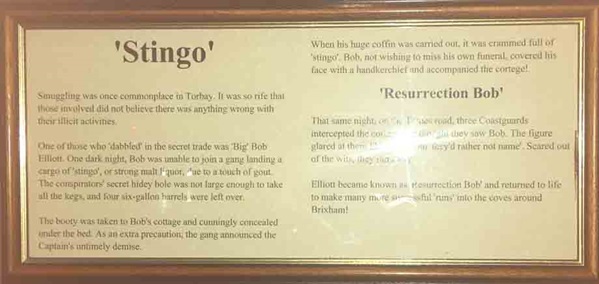
The text reads: Smuggling was once commonplace in Torbay. It was so rife that those involved did not believe there was anything wrong with their illicit activities.
One of those who dabbled in the secret trade was Big Bob Elliot. One dark night, Bob was unable to join a gang landing a cargo of ‘stingo’, or strong malt liquor, due to a touch of gout. The conspirators’ secret hidey hole was not large enough to take all the kegs, and four six gallon barrels were left over.
The booty was taken to Bob’s cottage and cunningly concealed under the bed. As an extra precaution, the gang announced the Captain’s untimely demise.
When his huge coffin was carried out, it was crammed full of ‘stingo’. Bob, not wishing to miss his own funeral, covered his face with a handkerchief and accompanied the cortege!
That same night, on the road, three coastguards intercepted the cortege and thought they saw Bob. The figure glared at them like one whom ‘they’d rather not name’. Scared out of their wits, they ran away.
Elliot became known as Resurrection Bob and returned to life to make many more successful runs into the coves around Brixham!
Above: Smuggler’s defeated
Right: The Smuggler’s Intrusion.
Text about Flora Thompson.
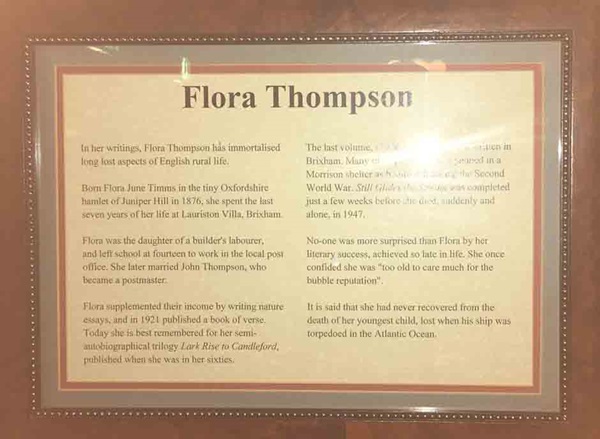
The text reads: In her writings, Flora Thompson has immortalised long lost aspects of English rural life.
Born Flora June Timms in the tiny Oxfordshire hamlet of Juniper Hill in 1876, she spent the last seven years of her life at Lauriston Villa, Brixham.
Flora was the daughter of a builder’s labourer and left school at fourteen to work in the local post office. She later married John Thompson, who became a postmaster.
Flora supplemented their income by writing nature essays, and in 1921 published a book of verse. Today she is best remembered for her semi-autobiographical trilogy Lark Rise to Candleford, published when she was in her sixties.
The last volume Candleford Green was written in Brixham. Many of its passages were penned in a Morrison shelter as bombs fell during the Second World War. Still Glides the Stream was completed just a few weeks before she died, suddenly and alone, in 1947.
No one was more surprised than Flora by her literary success, achieved so late in life. She once confided she was “too old to care much for the bubble reputation”.
It is said that she never recovered from the death of her youngest child, lost when his ship was torpedoed in the Atlantic Ocean.
Prints and text about Jesse Boot.
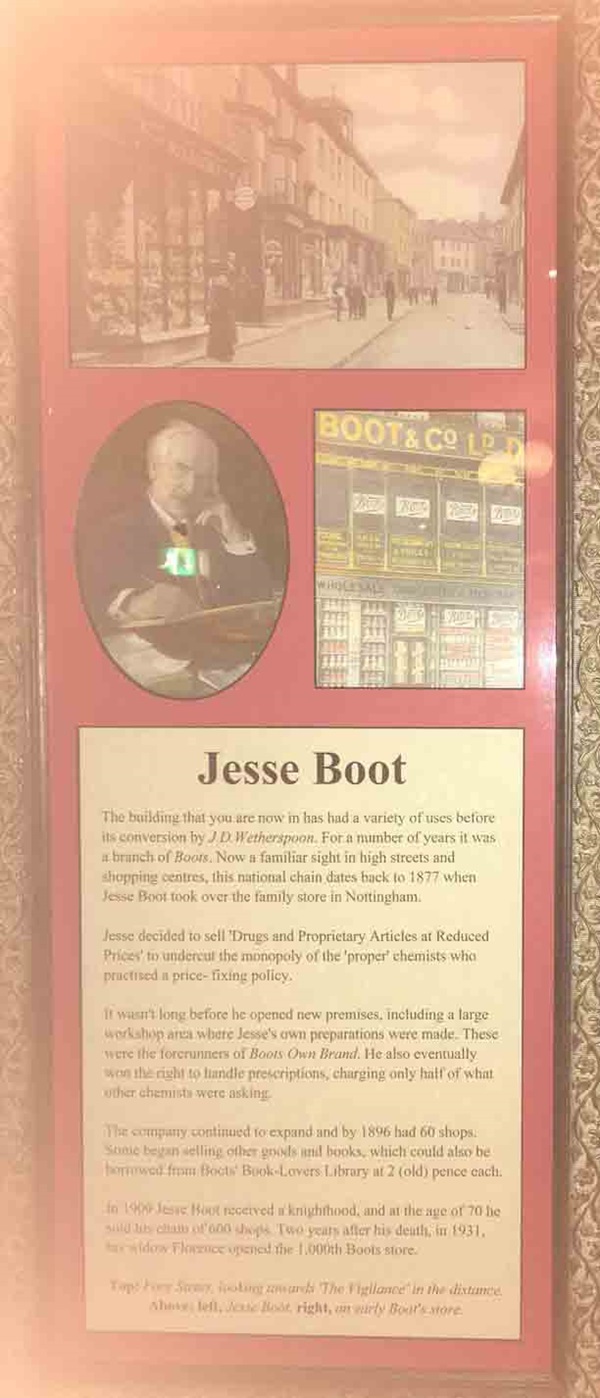
The text reads: The building that you are now in has had a variety of uses before its conversion by J D Wetherspoon. For a number of years it was a branch of Boots. Now a familiar sight in high streets and shopping centres, this national chain dates back to 1877 when Jesse Boot took over the family store in Nottingham.
Jesse decided to sell ‘drugs and proprietary articles at reduced prices’ to undercut the monopoly of the ‘proper’ chemists who practised a price fixing policy.
It wasn’t long before he opened a new premises, including a large workshop area where Jesse’s own preparations were made. These were the forerunners of Boots Own Brand. He also won the right to handle prescriptions, charging only half of what other chemists were asking.
The company continued to expand and by 1896 had 60 shops. Some began selling other goods and books, which could also be borrowed from Boots’ Book-Lovers Library at 2(old) pence each.
In 1909 Jesse Boot received a knighthood, and at the age of 70 he sold his chain of 600 shops. Two years after his death, in 1931, his widow Florence opened the 1,000th Boots store.
Top: Fore Street, looking towards The Vigilance in the distance
Above: left, Jesse Boot, right, an early Boot’s store.
Prints and text about the Vigilance.
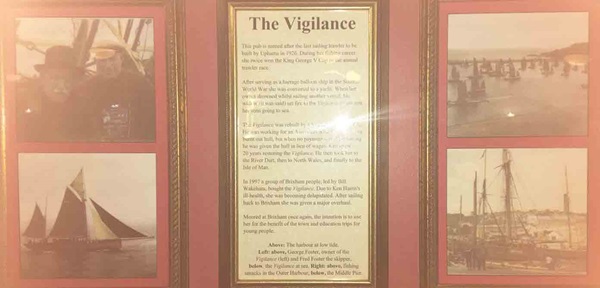
The text reads: This pub is named after the last sailing trawler to be built by Uphams in 1926. During her fishing career she twice won the King George V Cup in the annual trawler race.
After serving as a barrage balloon ship in the Second World War she was converted to a yacht. When her owner drowned whilst sailing another vessel, his widow (it was said) set fire to the Vigilance to prevent her sons going to sea.
The vigilance was rebuilt by a local man Ken Harris. He was working for an Australian who had bought the burnt out hull, but when no payment was forthcoming he was given the hull in lieu of wages. Ken spent 20 years restoring the Vigilance. He then took her to the River Dart, then to north Wales, and finally to the Isle of Man.
In 1997 a group of Brixham people, led by Bill Wakeham, bought the Vigilance. Due to Ken Harris’ ill health, she was becoming dilapidated. After sailing back to Brixham she was given a major overhaul.
Moored at Brixham once again, the intention is to use her for the benefit of the town and education trips for young people.
Above: The harbour at low tide
Left: above, George Foster, owner of the Vigilance (left) and Fred Foster the skipper, below, the Vigilance at sea.
Right: above, fishing smacks in the outer harbour, below, the middle pier.
Text about Brixham’s poetic preacher.
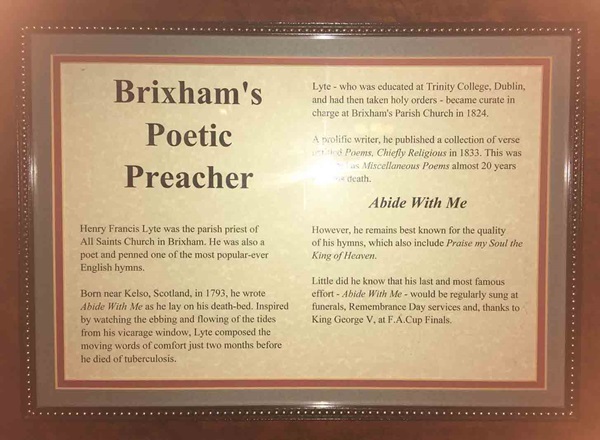
The text reads: Henry Francis Lyte was the parish priest of All Saints Church Brixham. He was also a poet and penned one of the most popular ever English hymns.
Born near Kelso, Scotland, in 1973, he wrote Abide With Me as he lay on his death bed. Inspired by watching the ebbing and flowing of the tides from his vicarage window, Lyte composed the moving words of comfort just two months before he died of tuberculosis.
Lyte – who was educated at Trinity College, Dublin, and had then taken holy orders – became curate in charge at Brixham’s Parish Church in 1824.
A prolific writer, he published a collection of verses entitled Poems, Chiefly Religions in 1833. This was published as Miscellaneous Poems almost 20 years after his death.
However, he remains best known for the quality of his hymns, which also include Praise my Soul the King of Heaven.
Little did he know that his last and most famous effort – Abide With Me – would be regularly sung at funerals, Remembrance Day services and, thanks to King George V, at FA Cup Finals.
Above: Reverend Henry Lyte.
A photograph of Middle Street, Brixham, c1905.
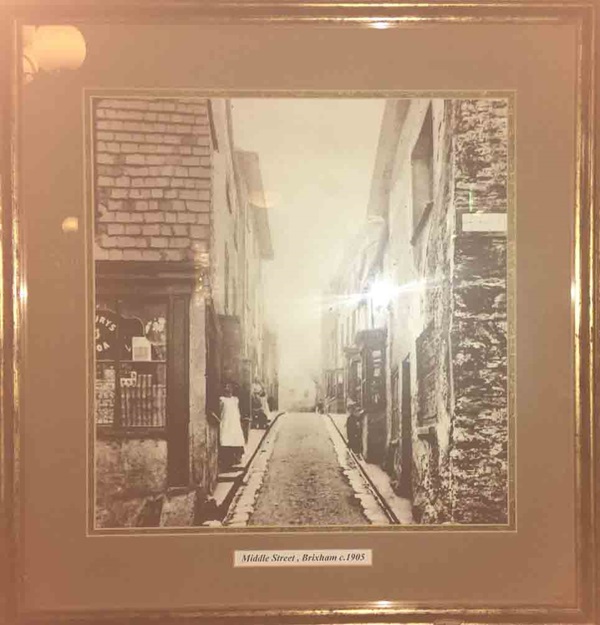
A photograph of The Cross from New Road, Brixham, c1910.
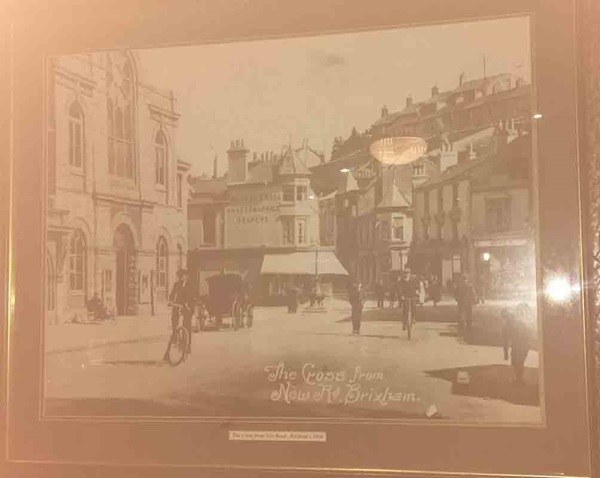
External photograph of the building – main entrance.
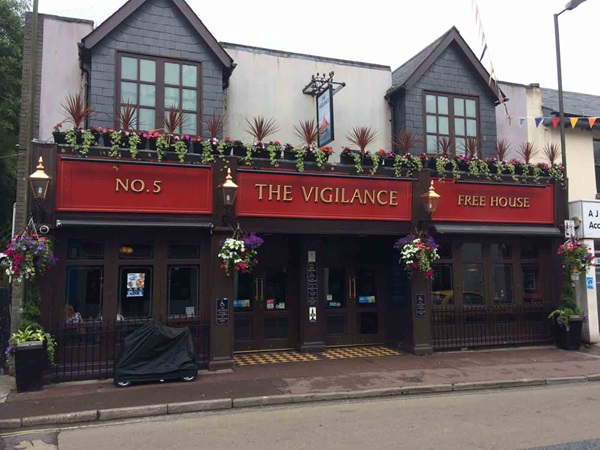
If you have information on the history of this pub, then we’d like you to share it with us. Please e-mail all information to: pubhistories@jdwetherspoon.co.uk